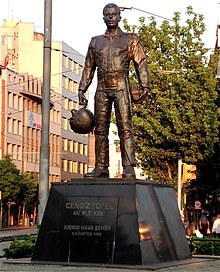

Turkish Cypriot nationalism is an ethnic nationalism supporting the independence of the Turkish Republic of Northern Cyprus (TRNC) and mostly desires that the TRNC stay independent from Turkey while opposing the idea of a united Cyprus with the Greek-dominated Republic of Cyprus. The objective of taksim, that is, the partition of the island of Cyprus into Turkish and Greek portions, is widespread among Turkish Cypriot nationalists. Nevertheless, a considerable number of them wish for Turkey to annex Cyprus.[1][2]

In 1911, 3 rallies against enosis (unification of Cyprus and Greece) were made by Turkish Cypriots all around the island. These rallies were the first major incident of Turkish Cypriot nationalism in 20th century and the first organized action against enosis by the Turkish Cypriots.[3] The 1920s was to prove a critical decade in terms of stricter ethno-religious compartments; hence, Turkish Cypriots who remained on the island gradually embraced the ideology of Turkish nationalism due to the impact of the Kemalist Revolution.[4]
In 1950s and 1960s, Turkish Cypriot nationalism developed mainly in response to Greek and Greek Cypriot nationalism and their desire for enosis, union of the whole island with Greece.[5][6][7] Initially, Turkish Cypriots favoured the continuation of British rule.[8] However, they were alarmed by the Greek Cypriot calls for enosis, as they saw that the union of Crete with Greece had led to the exodus of Cretan Turks, which was a precedent to be avoided,[9][10] and they took a pro-partition stance in response to the militant activity of the EOKA.[11] The slogan "Either Taksim or Death" was frequently used in Turkish Cypriot and Turkish protests in the late 1950s and throughout the 1960s. Although after the Zurich and London Conferences, Turkey seemed both to accept the existence of the Cypriot state and to distance itself from its policy of favouring the partition of the island, the goal of Turkish and Turkish Cypriot leaders remained that of creating an independent Turkish state in the northern part of the island.[12]
On 6 August 1964, units of the Cypriot National Guard and Turkish Cypriot armed groups started to clash near Kokkina. On 8 August 1964, after waiting for nearly two days, Turkey intervened, once it had become clear that the Greek Cypriots would not withdraw from Kokkina, but simply commit more and more siege forces until the Turkish Cypriots ran out of supplies. The incident was an important turning point in both Turkish and Turkish Cypriot nationalism, and it caused a massive increase in nationalist opinions among the Turkish Cypriots. This increase was mostly in favour of idea of Turkish annexation of Cyprus.[13][14]
On 20 July 1974, Turkey launched an invasion of the island following a Greek Junta sponsored coup d'état against President Makarios, aimed at uniting the island with Greece. The second Turkish offensive, codenamed "Attila 2", took place between 14 and 18 August 1974 and extended as far west as the Kokkina enclave.
The rise of Turkish nationalism among the Turkish Cypriots can be largely seen as a response to the Greek Cypriot national "awakening" and campaign for union with Greece.
The Turkish Cypriot nationalism developed mainly in reaction to the Greek Cypriot national desire for union with Greece.
Greek Cypriots engaged in a military campaign for enosis, union with Greece. Turkish Cypriots, in response, expressed their desire for taksim, partition of the island.
In line with the nationalist rhetoric that "Cyprus is Turkish", Menderes predicated his declaration upon the geographic proximity between Cyprus and Anatolia, thereby defining "Cyprus as an extension of Anatolia". It was striking that Menderes rejected partitioning the island into two ethnic states, a position that would define Turkey's foreign policy regarding Cyprus after 1957
The educational and political mobilisation between 1948-1958, aiming at raising Turkish national consciousness, resulted in the involving Turkey as motherland in the Cyprus Question. From then on, Turkey, would work hand in hand with the Turkish Cypriot leadership and the British government to oppose the Greek Cypriot demand for enosis and realise the partition of Cyprus, which meanwhile became the national policy.
|
| |
|---|---|
| Albania |
|
| Azerbaijan |
|
| Belgium |
|
| Bosnia and Herzegovina |
|
| Croatia |
|
| Cyprus |
|
| Denmark |
|
| Finland |
|
| France |
|
| Georgia |
|
| Germany |
|
| Greece |
|
| Italy |
|
| Kazakhstan |
|
| North Macedonia |
|
| Moldova |
|
| Netherlands |
|
| Norway |
|
| Poland |
|
| Romania |
|
| Russia |
|
| Serbia |
|
| Spain |
|
| Sweden |
|
| Turkey |
|
| Ukraine |
|
| United Kingdom |
|
| See also |
|